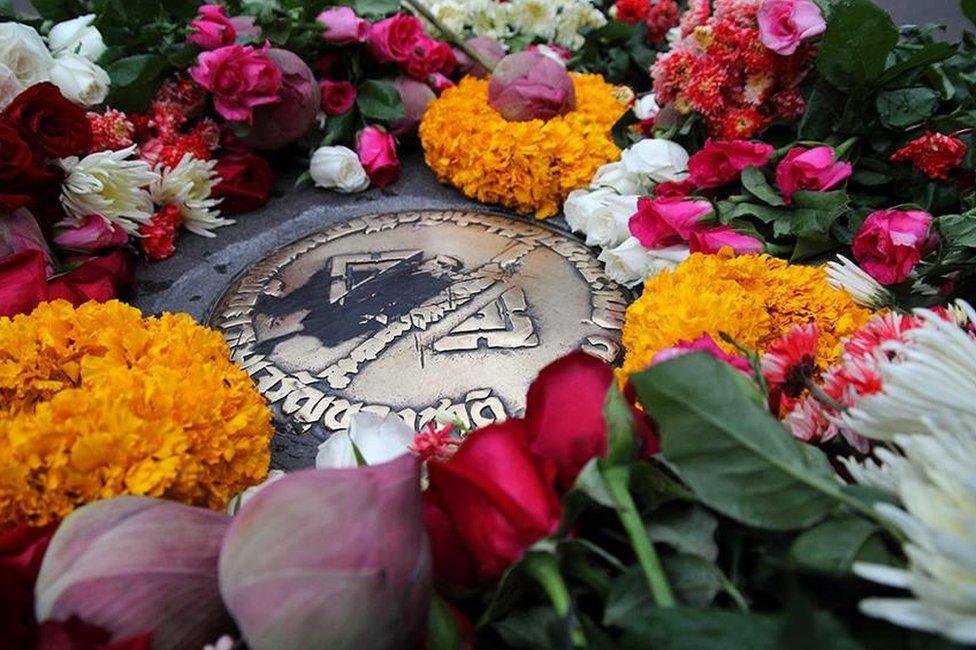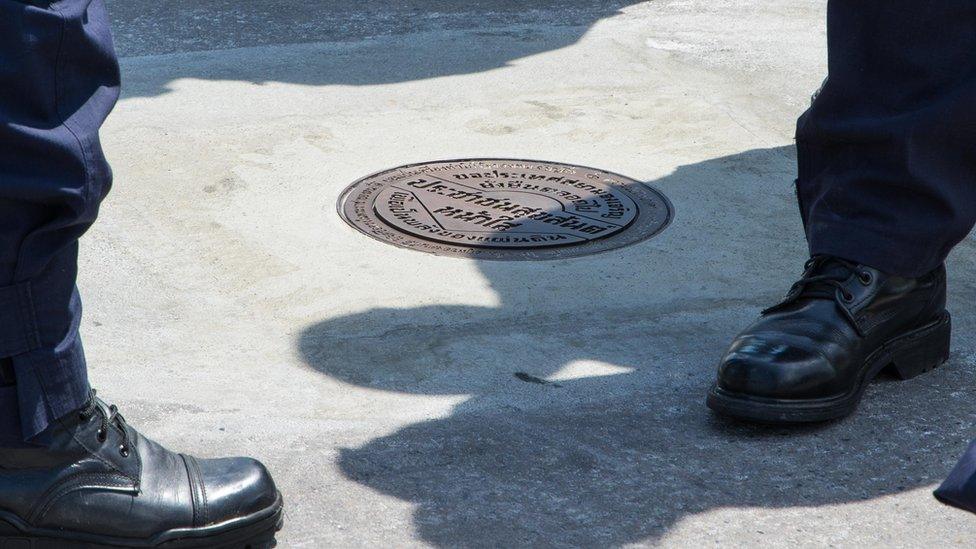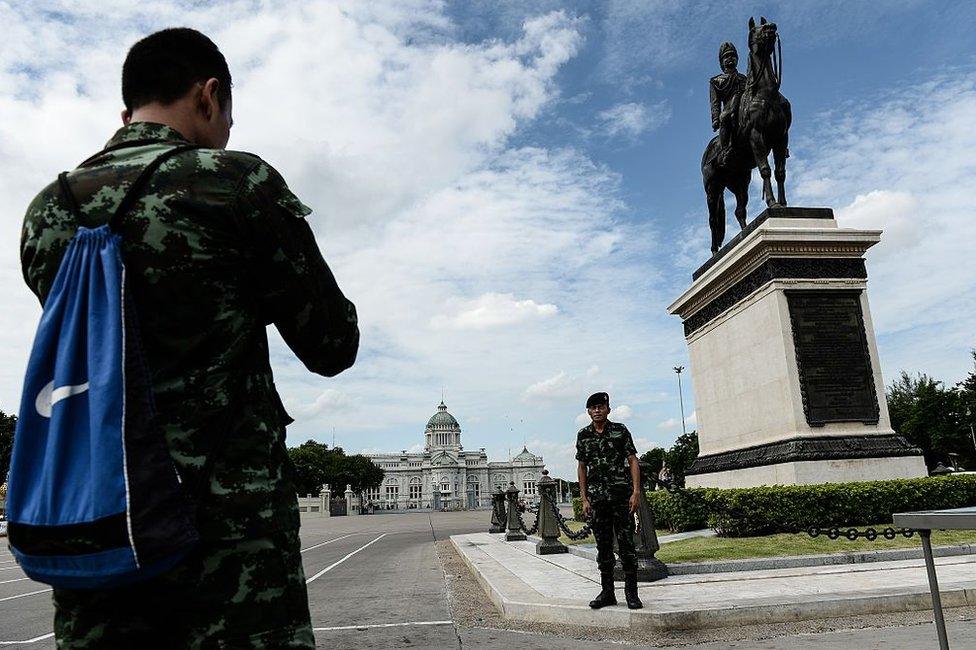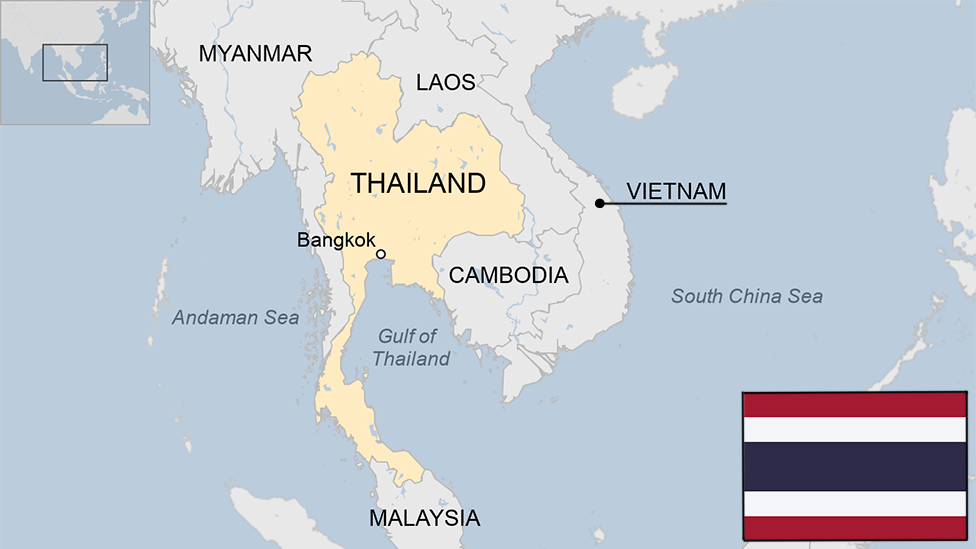The mystery of the missing brass plaque
- Published

The plaque, seen here in a file picture, was occasionally decorated with flowers by activists
For more than 80 years a small brass plaque, no larger than a dinner plate, sat embedded in the tarmac in front of Bangkok's Ananta Samakhom Throne Hall, worn down after being driven over countless of times by traffic.
Very few Thais even knew of its existence, apart from dedicated pro-democracy activists who would occasionally clean the plaque or decorate it with flowers.
Yet the plaque is one of the very few monuments to mark the most significant moment in modern Thai history.
In June 1932, a revolution overthrew 700 years of absolute monarchy and a constitutional political structure, requiring non-royal governments elected by the people, was introduced.
Four-and-a-half years later, one of the leaders of that uprising and the first post-revolution prime minister Phraya Phahol held a small ceremony, embedding the plaque into the ground at the spot where he had first announced the end of the absolute monarchy.
The inscription on it read: "Here on 24 June 1932 at dawn, the People's Party proclaimed a constitution for the country's advancement."
Earlier this month two teams of students from Kasetsart University were sent by their professor to study the plaque.
The first group, on 2 April, found it intact. A second group who visited it on 8 April discovered that it had been replaced.
Neatly cemented in the same spot was a new plaque, with a different message: "To love and respect the Buddhist trinity, one's own state, one's own family, and to have a heart faithful to your monarch, will bring prosperity to the country".
The same inscription surrounds the Chakri Star, a symbol of the reigning dynasty in Thailand.

The new plaque was installed in early April
Unsurprisingly there has been an uproar, as pro-democracy activists, historians and social media commentators have protested against this apparent violation of a piece of Thailand's historic heritage.
This was no casual act of vandalism.
A fringe, ultra-royalist group had threatened to remove the plaque last year, but given the location, it seems unlikely even they would dare carry out their threat without significant official backing.
Deliberate snub
The instigators of the 1932 revolution had chosen the location for their early morning announcement with care. Symbols, and locations, have always mattered in Thai power politics.
Royal Plaza was the dramatic entrance to the new district of Dusit, built by Thailand's greatest absolute monarch, Chulalongkorn, as a more modern centre of royal power, away from the glittering palaces by the river.
It marks the end of Ratchadamnoen Avenue, the grand royal boulevard connecting the two districts, and is dominated by a large statue of King Chulalongkorn astride a horse.
The little brass plaque, stuck right next to the statue, was a deliberate snub, by a government determined to curb, or even end, royal power.

The plaque was embedded in the road near the statue
But they failed. During the long reign of King Bhumibol, which ended with his death last October, royal power and prestige were restored to levels unknown since the days of absolute kings.
Royal Plaza remains a potent symbol of the monarchy's elevated status.
The new King Vajiralongkorn chose the imposing throne hall to host an elaborate formal ceremony, unseen in almost half a century, on 6 April, giving his royal approval to a new constitution drafted by Thailand's military rulers.
Photographs published in the Thai media suggest the plaque was removed on the night before that ceremony.
The reaction of the Thai authorities to the theft has left people perplexed. Prime Minister Prayuth Chan-ocha dismissed it as unimportant.
"What good will it do to demand its return?" he responded to journalists, adding warnings not to organise protests about the plaque.

Nuttaa Mahattana (left) and Apisit Sapnaphaphan (right) are among several pro-democracy activists questioning the plaque's disappearance
The police insisted they could not investigate the disappearance because they did not know who owned the plaque. The deputy police chief even suggested that it had originally been put illegally in Royal Plaza, even though it was done by the government of the day.
One activist who turned up at Royal Plaza to protest was detained; an opposition politician, who posted that the plaque was a national asset and should be protected by law, is being charged under the tough Computer Crimes Act.
Two more who filed a complaint to the local police were warned not to go there, and instead bussed to Bangkok City Hall, where they were told that all 11 CCTV cameras in the area had been removed days before the plaque was taken.

The new plaque was guarded by several Thai policemen when the BBC visited this week
For a few hours a fence was erected around the new plaque to stop people photographing it, until the police realised it was a hazard to traffic, and took it down.
Subject of debate
Because 1932 was such a pivotal moment in Thai history, it has long been the subject of debate among the country's main political factions, each aiming to co-opt the event to enhance its own legitimacy.
Some of the language used by the leaders of the uprising was stridently critical of the monarchy. It could hardly be republished now, under the exceptionally harsh interpretation of the lese majeste law used by today's military government.
But very quickly the uprising's leaders decided they needed the endorsement of their new regime by then-King Prajadhipok, softening their proposals to limit royal powers in the constitution they finalised by the end of 1932.
Relations between the two remained tense, with a failed royalist uprising in 1933 leading to the king eventually abdicating two years later.
That chaotic start to Thailand's first attempt at democracy has allowed royalists to present it more as a gift from a caring monarchy, and for democrats and republicans to present democracy as something that must stem from the will of the people.
In many ways, Thailand's recent political turmoil reflects a debate over the true source of political legitimacy in the country which has never been settled.
So whoever removed the little brass plaque, with its brief homage to the first "people's constitution", was sending a message, or adjusting the symbolic balance in Royal Plaza.
The evasive responses of the government and police show it is a very sensitive matter that they are reluctant to investigate.
They are making it clear they will not tolerate anyone else investigating the missing piece of history either.
- Published6 April 2017

- Published16 August 2024

- Published13 October 2016
